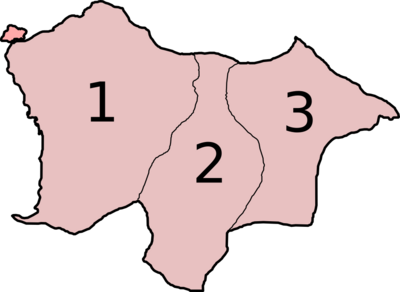Administrative divisions of Rhayna (Pacifica)

The UPRAN is a federal state with moderately delegated authority to four levels of local government that cover the entire country:
- 3 states (Rhayna, Alla-gy and Nea-gy)
- 40 provinces
- 46 urban conglomerates
- ? komiteias
The government structure is based on the 1965 Constitution, adopted after the end of the Rhaynan Civil War and the unification of Moellia.
States
There are 3 states spanning the United Provinces:
|
 |
The distribution of Rhaynan states is almost homogeneous, with the biggest state, Rhayna, being only 1.75 times bigger than the smallest state, Nea-gy. However, the distribution of factors like gross domestic product or population is far from homogeneous. For example, Rhayna is the most developed state in the union, while Nea-gy is the state with most population out of the three, despite being smaller than Rhayna and comparable in size to the state of Alla-gy.
The UPRAN is a mostly desert nation, meaning that traditionally and currently human settlements concentrate around water sources and coasts, while the interior of the nation and the two mountainous ranges remain mostly unpopulated. Today, the majority of the population of the country is made up of the large cities along Lake Kryo, and the more distributed population centres of Nea-gy.
The state system was built in 1965 with the end of the Rhaynan Civil War and the unification of the Aegean-descendant nations of Moellia. While the area today occupied by the state of Rhayna was already covered by the nation of the same name before the war, the unification of multiple nations into single states was required for the states of Alla-gy and Nea-gy. However, these two regions were already mainly controlled by their respective regional powers.
The unification of the states was made after the Rhaynan Civil War, with its roots in the political ideology of Pan-Moellianism. Cultivated during the hardest late periods of the war, this ideology had the focus of stopping conflict between the relatively similar cultures of Moellia that had been constant since their settlement.
The state is the most important and powerful subdivision of the nation's territory; serving as the basis for many administrative divisions, such as education and healthcare, as well as being a socially and historically recognizable territorial division of the country.